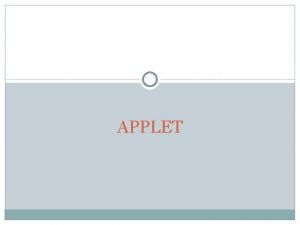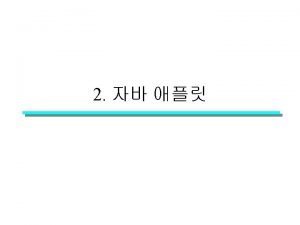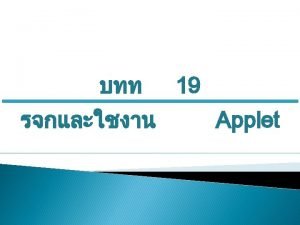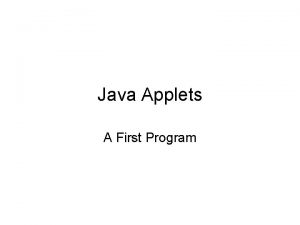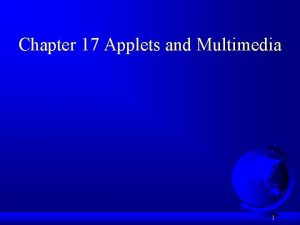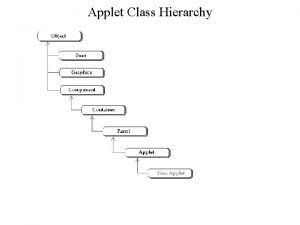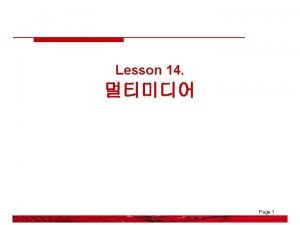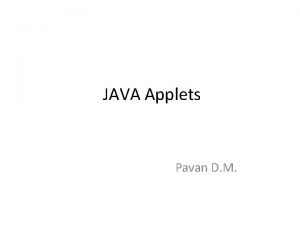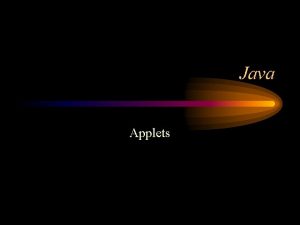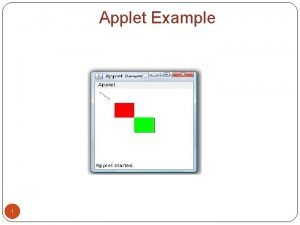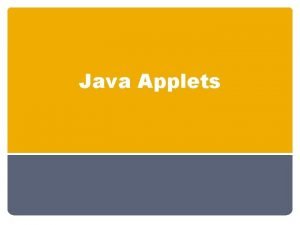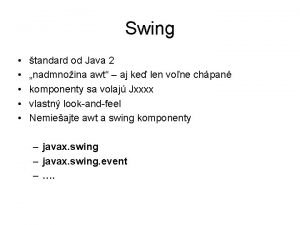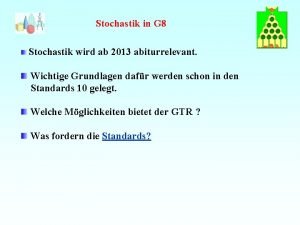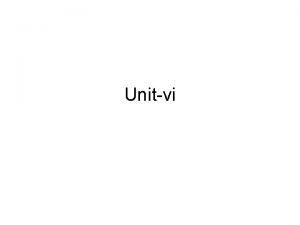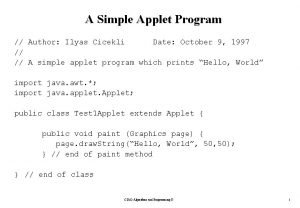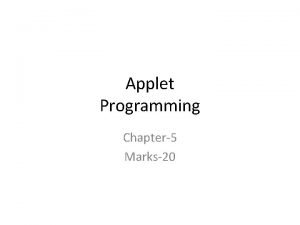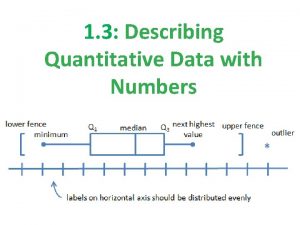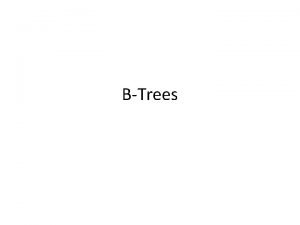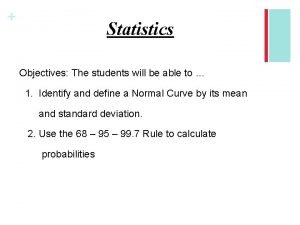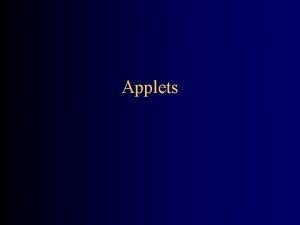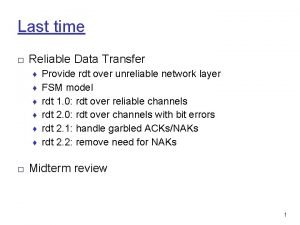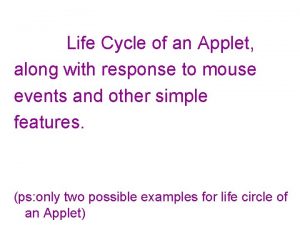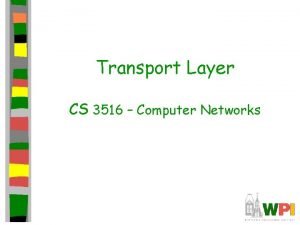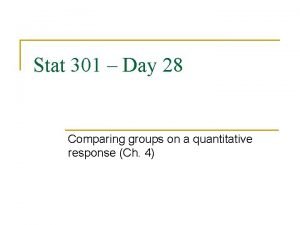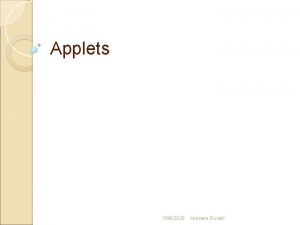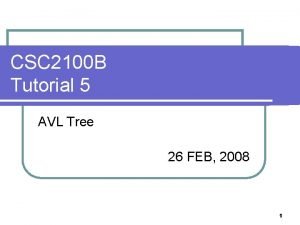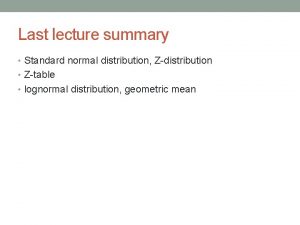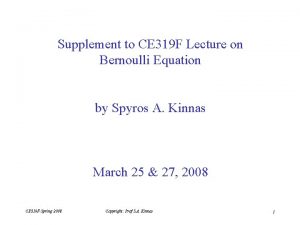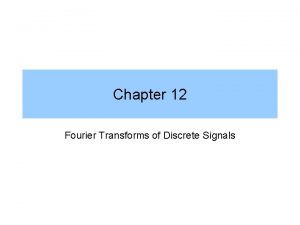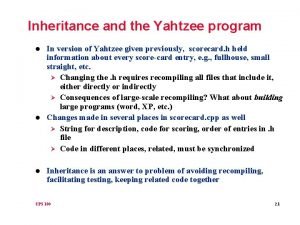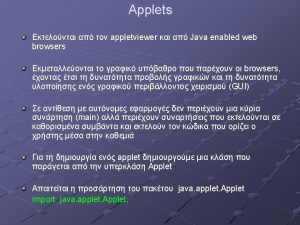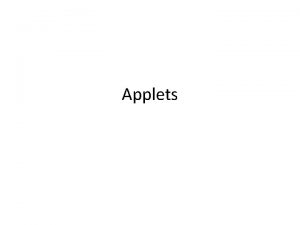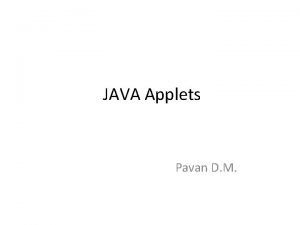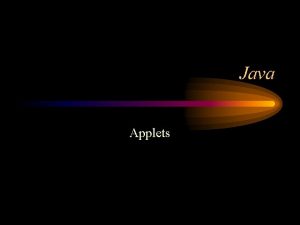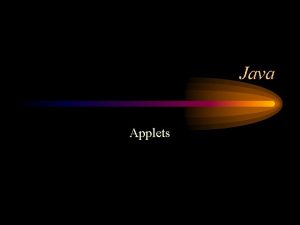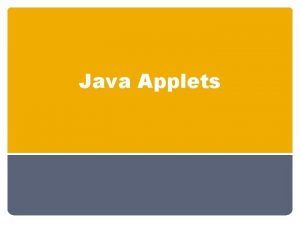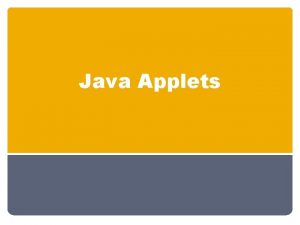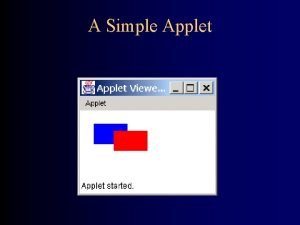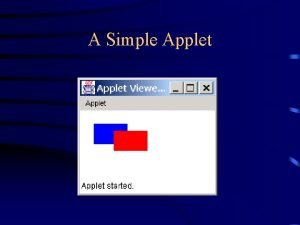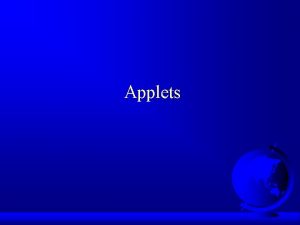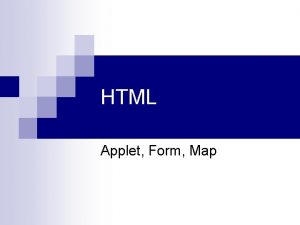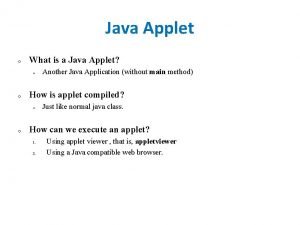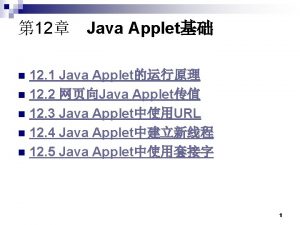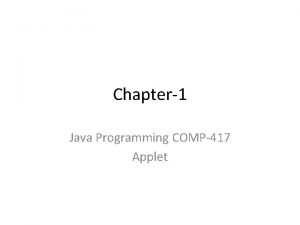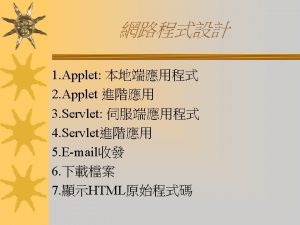Java Applets Applet in Java Applets are small














![The <applet> Tag < APPLET [CODEBASE = codebase. URL] CODE = applet. File [ALT The <applet> Tag < APPLET [CODEBASE = codebase. URL] CODE = applet. File [ALT](https://slidetodoc.com/presentation_image_h/a23c9b916647b2af90c5c911a3b886cc/image-15.jpg)




























![Graphics class Methods • Drawing Polygons void draw. Polygon(int x. Points[], int y. Points[], Graphics class Methods • Drawing Polygons void draw. Polygon(int x. Points[], int y. Points[],](https://slidetodoc.com/presentation_image_h/a23c9b916647b2af90c5c911a3b886cc/image-44.jpg)
![Graphics class Methods • Drawing Solid Polygons void fill. Polygon(int x. Points[], int y. Graphics class Methods • Drawing Solid Polygons void fill. Polygon(int x. Points[], int y.](https://slidetodoc.com/presentation_image_h/a23c9b916647b2af90c5c911a3b886cc/image-45.jpg)










![font methods • get. All. Fonts() public abstract Font[] get. All. Fonts() Returns an font methods • get. All. Fonts() public abstract Font[] get. All. Fonts() Returns an](https://slidetodoc.com/presentation_image_h/a23c9b916647b2af90c5c911a3b886cc/image-56.jpg)
- Slides: 56

Java Applets

Applet in Java • Applets are small Java applications that can be accessed on an Internet server, transported over Internet, and can be automatically installed and run as apart of a web document. Any applet in Java is a class that extends the java. applet. Applet class. • An Applet class does not have any main() method.

Local Applets • Local applets are applet types that are developed and stored in local system. The web page will search the local system directories, find the local applet and execute it. Execution of local applet does not require internet connection.

Specifying a Local Applet <applet codebase="path" code="New. Applet. class" width=120 height=120 > </apple>

Remote Applets • Remote applets are applet types that are developed by someone else and stored on a remote system connected to the internet. Execution of remote applet requires internet connection.

Specifying a Remote Applet <applet codebase="http: //www. myconnect. com/applets/ " code="New. Applet. class" width=120 height=120 > </applet>

Life Cycle of an Applet

Lifecycle of Java Applet • • • Applet is initialized. Applet is started. Applet is painted. Applet is stopped. Applet is destroyed.

Initialization State • init: This method is intended for whatever initialization is needed for your applet. It is called after the param tags inside the applet tag have been processed. public void init() { ………. . }

Running State • start: This method is automatically called after the browser calls the init method. It is also called whenever the user returns to the page containing the applet after having gone off to other pages. public void start() { ………. . }

Idle or Stopped State • stop: This method is automatically called when the user moves off the page on which the applet sits. It can, therefore, be called repeatedly in the same applet. public void stop() { ………. . }

Dead State • destroy: This method is only called when the browser shuts down normally. Because applets are meant to live on an HTML page, you should not normally leave resources behind after a user leaves the page that contains the applet. public void destroy() { ………. . }

Display State • paint: Invoked immediately after the start() method, and also any time the applet needs to repaint itself in the browser. The paint() method is actually inherited from the java. awt. public void paint(Graphics g) { ………. . }

![The applet Tag APPLET CODEBASE codebase URL CODE applet File ALT The <applet> Tag < APPLET [CODEBASE = codebase. URL] CODE = applet. File [ALT](https://slidetodoc.com/presentation_image_h/a23c9b916647b2af90c5c911a3b886cc/image-15.jpg)
The <applet> Tag < APPLET [CODEBASE = codebase. URL] CODE = applet. File [ALT = alternate. Text] [NAME = applet. Instance. Name] WIDTH = pixels HEIGHT = pixels [ALIGN = alignment] [VSPACE = pixels] [HSPACE = pixels] > [< PARAM NAME = applet. Parameter 1 VALUE = value >] [< PARAM NAME = applet. Parameter 2 VALUE = value >] </APPLET>

<applet> Tag Required Attributes Attribute Value Description code URL Specifies the file name of a Java applet width pixels Specifies the width of an applet height pixels Specifies the height of an applet

Optional Attributes Attribute Value Description codebase URL Specifies a relative base URL for applets specified in the code attribute alt text Specifies an alternate text for an applet name Defines the name for an applet (to use in scripts) align left right top bottom middle baseline Specifies the alignment of an applet according to surrounding elements hspace pixels Defines the horizontal spacing around an applet vspace pixels Defines the vertical spacing around an applet

Creating applet //First. java import java. applet. Applet; import java. awt. Graphics; public class First extends Applet { public void paint(Graphics g) { g. draw. String("welcome", 150); } }

Adding Applet To HTML file myapplet. html <html> <body> <applet code="First. class" width="300" height="300"> </applet> </body> </html>

How to run an Applet? There are two ways to run an applet • By html file. • By applet. Viewer tool (for testing purpose).

Embedding <applet>tags in java code //First. java import java. applet. Applet; import java. awt. Graphics; public class First extends Applet { public void paint(Graphics g) { g. draw. String("welcome to applet", 150); } } /* <applet code="First. class" width="300" height="300"> </applet> */

• To execute the applet by appletviewer tool, write in command prompt: c: >javac First. java c: >appletviewer First. java

passing parameter to applet <PARAM> tags are the only way to specify applet-specific parameters. < PARAM NAME = applet. Parameter 1 VALUE = value > Attribute Value Description name Specifies the name of a parameter value Specifies the value of the parameter We can get any information from the HTML file as a parameter. For this purpose, Applet class provides a method named get. Parameter(). public String get. Parameter(String parameter. Name)

Example of using parameter in Applet //Use. Param. java import java. applet. Applet; import java. awt. Graphics; public class Use. Param extends Applet { public void paint(Graphics g) { String str=get. Parameter("msg"); g. draw. String(str, 50); } }

myapplet. html <html> <body> <applet code="Use. Param. class" width="300" height="300"> <param name="msg" value="Welcome to applet"> </applet> </body> </html>

Adding controls to applets User. Input. java import java. awt. *; import java. applet. *; public class User. Input extends Applet { Text. Field text 1, text 2; public void init() { text 1 = new Text. Field(8); text 2 = new Text. Field(8); add(text 1); add(text 2); text 1. set. Text("0"); text 2. set. Text("0"); }

public void paint(Graphics g) { int x=0, y=0, z=0; String s 1, s 2, s; g. draw. String("Input a number in each box ", 10, 50); try { s 1 = text 1. get. Text(); x = Integer. parse. Int(s 1); s 2 = text 2. get. Text(); y = Integer. parse. Int(s 2); } catch(Exception e) {} z = x + y; s = String. value. Of(z); g. draw. String("The Sum is : ", 10, 75); g. draw. String(s, 100, 75); }

public boolean action(Event event, Object obj) { repaint(); return true; } } User. Input. html <HTML> <HEAD> <TITLE>Getting Input from the User</TITLE> </HEAD> <BODY> <APPLET Code=“User. Input. class" Width=400 Height=300> </APPLET> </BODY> </HTML>


Handle Action Events for AWT Button Example import java. applet. *; import java. awt. event. Action. Event; import java. awt. event. Action. Listener; /* <applet code="HAEEx. class" width=200 height=200> </applet> */ public class HAEEx extends Applet implements Action. Listener { String action. Message="";

public void init() { Button B 1 = new Button("Ok"); Button B 2 = new Button("Cancel"); add(B 1); add(B 2); B 1. add. Action. Listener(this); B 2. add. Action. Listener(this); } public void paint(Graphics g) { g. draw. String(action. Message, 10, 50); }

public void action. Performed(Action. Event ae) { String action = ae. get. Action. Command(); if(action. equals("Ok")) action. Message = "Ok Button Pressed"; else if(action. equals("Cancel")) action. Message = "Cancel Button Pressed"; repaint(); } }

Graphics Programming

The coordinate plane A coordinate system is a method for specifying the location of points in space. In the case of the AWT, this space is a two-dimensional surface called a plane. Each location in a plane can be specified by two integers, called the x and y coordinates. The values of the x and y coordinates are calculated in terms of the point's respective horizontal and vertical displacement from the origin. In the case of the AWT, the origin is always the point in the upper-left corner of the plane. It has the coordinate values 0 (for x) and 0 (for y).

Graphics class Methods • Drawing Lines void draw. Line(int x 1, int y 1, int x 2, int y 2) It draws a straight line, a single pixel wide, between the specified beginning and ending points. The line will be drawn in the current foreground color. Example: g. draw. Line(30, 300, 200, 10);

Graphics class Methods • Drawing Rectangles void draw. Rect(int x, int y, int width, int height) It draws a rectangle. It require, as parameters, the x and y coordinates at which to begin the rectangle, and the width and the height of the rectangle. Both the width and the height must be positive integers. Example: g. draw. Rect(400, 50, 200, 100);

Graphics class Methods • Drawing Rounded Rectangles void draw. Round. Rect(int x, int y, int width, int height, int arc. Width, int arc. Height) The rounded-rectangle graphics methods require two additional parameters, an arc width and an arc height, both of which control the rounding of the corners. Example: g. draw. Round. Rect(10, 100, 80, 50, 10);

Graphics class Methods • Drawing Filled/ Solid Rectangles void fill. Rect(int x, int y, int w, int h) It draws a solid rectangle. It also requires 4 parameters like draw. Rect() method. Example: g. fill. Rect(400, 50, 200, 100);

Graphics class Methods • Drawing Rounded Rectangles void fill. Round. Rect(int x, int y, int w, int h, int arc. Width, int arc. Height) It draws solid rounded-rectangle. It also takes 6 parameters like draw. Round. Rect() method. Example: g. fill. Round. Rect(10, 100, 80, 50, 10);

Graphics class Methods • Drawing Ellipses & Circles void draw. Oval(int x, int y, int w, int h) It draws outline of an oval. It takes parameters, the x and y coordinates of the center of the oval and the width and height of the oval. Example: g. draw. Oval(10, 100, 120);

Graphics class Methods • Drawing Solid Ellipses & Circles void fill. Oval(int x, int y, int w, int h) It draws a solid oval. It also takes 4 parameters like draw. Oval() method. Example: g. fill. Oval(10, 100, 120);

Graphics class Methods • Drawing Arcs void draw. Arc(int x, int y, int w, int h, int start. Angle, int arc. Angle) It draws an arc. It requires 6 parameters. First 4 parameters are same as draw. Oval() method and two additional parameters, a start angle and an arc angle, to specify the beginning of the arc and the size of the arc in degrees. Example: g. draw. Arc(60, 125, 80, 40, 180);

Graphics class Methods • Drawing Solid Arcs void fill. Arc(int x, int y, int w, int h, int start. Angle, int arc. Angle) It draws solid arc. It also requires 6 parameters like draw. Arc() method. Example: g. fill. Arc(60, 125, 80, 40, 180);
![Graphics class Methods Drawing Polygons void draw Polygonint x Points int y Points Graphics class Methods • Drawing Polygons void draw. Polygon(int x. Points[], int y. Points[],](https://slidetodoc.com/presentation_image_h/a23c9b916647b2af90c5c911a3b886cc/image-44.jpg)
Graphics class Methods • Drawing Polygons void draw. Polygon(int x. Points[], int y. Points[], int n. Points) It draws outline of polygon. It requires 3 parameters. Two arrays of integers, one representing the successive x coordinates and the other representing the successive y coordinates. And an integer for the total number of points. Example: int x. Points[]={10, 170, 80, 10}; int y. Points[]={20, 40, 140, 20}; int n. Points= x. Points. length; g. draw. Polygon(x. Points, y. Points, n. Points);
![Graphics class Methods Drawing Solid Polygons void fill Polygonint x Points int y Graphics class Methods • Drawing Solid Polygons void fill. Polygon(int x. Points[], int y.](https://slidetodoc.com/presentation_image_h/a23c9b916647b2af90c5c911a3b886cc/image-45.jpg)
Graphics class Methods • Drawing Solid Polygons void fill. Polygon(int x. Points[], int y. Points[], int n. Points) It draws solid polygon. It requires 3 parameters like draw. Polygon() method. Example: int x. Points[]={10, 170, 80, 10}; int y. Points[]={20, 40, 140, 20}; int n. Points= x. Points. length; g. fill. Polygon(x. Points, y. Points, n. Points);

import java. awt. *; import java. applet. *; public class Face extends Applet { public void paint(Graphics g) { g. draw. Oval(40, 120, 150); //Head g. draw. Oval(57, 75, 30, 20); //Left eye g. draw. Oval(110, 75, 30, 20); //Right eye g. fill. Oval(68, 81, 10); //Pupil (left) g. fill. Oval(121, 81, 10); //Pupil (right) g. draw. Oval(85, 100, 30); //Nose g. fill. Arc(60, 125, 80, 40, 180); //Mouth g. draw. Oval(25, 92, 15, 30); //Left ear g. draw. Oval(160, 92, 15, 30); //Right ear } }


Color & Fonts • set. Color() public abstract void set. Color(Color c) Sets this graphics context's current color to the specified color. All subsequent graphics operations using this graphics context use this specified color. • get. Color() public abstract Color get. Color() Gets this graphics context's current color.

Color & Fonts • set. Back. Ground() void set. Background(mycolor) Sets the color of the background of an applet window. • set. Fore. Ground() void set. Foreground(mycolor) Sets the foreground color to a specific color. mycolor is one of the color constants or the new color created by the user.

Color & Fonts The list of color constants is given below: • Color. red • Color. orange • Color. gray • Color. dark. Gray • Color. light. Gray • Color. cyan • Color. pink • Color. white • Color. blue • Color. green • Color. black • Color. yellow

font class • Constructors public Font (String name, int style, int size) • There is a single constructor for Font. It requires a name, style, and size. name represents the name of the font to create, case insensitive. set. Font (new Font ("Times. Roman", Font. BOLD | Font. ITALIC, 20)); This can be also written as, Font f=new Font("Times. Roman", Font. BOLD | Font. ITALIC, 20); g. set. Font(f);

font class • Variables defined by font class: Three protected variables access the font setting. They are initially set through the Font constructor. To read these variables, use the Font class's "get" methods. • protected String name The name of the font. • protected int size The size of the font. • protected int style The style of the font. The style is some logical combination of the constants listed previously.

font methods • get. Family() public String get. Family () The get. Family() method returns the actual name of the font that is being used to display characters.

font methods • get. Font() public static Font get. Font (String name) The get. Font() method gets the font specified by the system property name. If name is not a valid system property, null is returned.

font methods • get. Fontname() String get. Font. Name() Returns the font face name of this Font. • get. Size() int get. Size() Returns the point size of this Font, rounded to an integer. • get. Style() int get. Style() Returns the style of this Font.
![font methods get All Fonts public abstract Font get All Fonts Returns an font methods • get. All. Fonts() public abstract Font[] get. All. Fonts() Returns an](https://slidetodoc.com/presentation_image_h/a23c9b916647b2af90c5c911a3b886cc/image-56.jpg)
font methods • get. All. Fonts() public abstract Font[] get. All. Fonts() Returns an array containing an instance of all fonts available in this Graphics Environment. • getavailablefontfamilyname() public abstract String[] get. Available. Font. Family. Names() Returns an array containing the names of all font families in this Graphics Environment
 Import java.applet.applet
Import java.applet.applet Applet class
Applet class Applet example
Applet example Import java.applet.applet
Import java.applet.applet Import java.applet.applet;
Import java.applet.applet; Import java.applet.applet
Import java.applet.applet Swing vs awt
Swing vs awt Insidan region jh
Insidan region jh Difference between local applet and remote applet
Difference between local applet and remote applet Erik poll
Erik poll Wisweb applets
Wisweb applets Wisweb applets
Wisweb applets Rossman chance applets
Rossman chance applets Java applet hello world
Java applet hello world Japplet example
Japplet example Moving ball program in java using applet
Moving ball program in java using applet Hierarchy of applet in java
Hierarchy of applet in java @games_comp
@games_comp Test java applet
Test java applet Import java.applet.*
Import java.applet.* Applet program in java
Applet program in java Html applet tag
Html applet tag Java applet program draw cartoon
Java applet program draw cartoon Applet structure in java
Applet structure in java Unit circle applet
Unit circle applet Applet example
Applet example Wat is een applet
Wat is een applet A term that applies to a program or applet
A term that applies to a program or applet Aj applet
Aj applet Formel von bernoulli erklärung
Formel von bernoulli erklärung Diff between awt and swing
Diff between awt and swing Reeses pieces applet
Reeses pieces applet Difference between applet and awt
Difference between applet and awt Applet
Applet Explain the applet life cycle
Explain the applet life cycle Iqr outlier rule
Iqr outlier rule Theory based inference applet
Theory based inference applet B tree applet
B tree applet Normal curve applet
Normal curve applet An applet is a of panel
An applet is a of panel Rdt time
Rdt time Applet life cycle
Applet life cycle Gbn applet
Gbn applet Simple random sample applet
Simple random sample applet Theory based inference applet
Theory based inference applet Theory-based inference applet
Theory-based inference applet Applet
Applet Applet
Applet Avl tutorial
Avl tutorial Zdistribution
Zdistribution Manometer applet
Manometer applet Fft applet
Fft applet Standing wave applet
Standing wave applet Java yahtzee code
Java yahtzee code Import java.awt.* import java.awt.event.*
Import java.awt.* import java.awt.event.* Import java util scanner
Import java util scanner Import java.util.scanner;
Import java.util.scanner;


